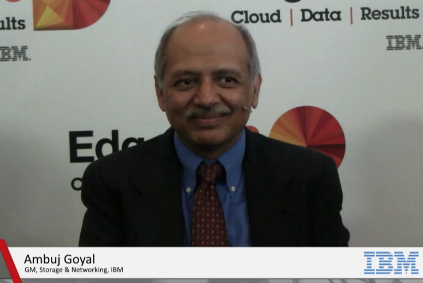 NEWS
NEWS
 NEWS
NEWS
 NEWS
NEWS
![]() On yesterday’s edition of theCube, co-hosts John Furrier and Dave Vallante were thrilled to be able to sit down with IBM’s GM of System Storage & networking Ambuj Goyal at the IBM Edge 2013 Conference in Las Vegas. During their discussion, Goyal gave a forthright explanation of IBM’s take on the evolution of software-defined storage and what this means for the future of Big Data analytics.
On yesterday’s edition of theCube, co-hosts John Furrier and Dave Vallante were thrilled to be able to sit down with IBM’s GM of System Storage & networking Ambuj Goyal at the IBM Edge 2013 Conference in Las Vegas. During their discussion, Goyal gave a forthright explanation of IBM’s take on the evolution of software-defined storage and what this means for the future of Big Data analytics.
Responding to Vallente’s assertion that IBM sees object-based access for applications as the future of storage, Goyal states that in fact “Big Blue” has a much broader vision. According to Goyal, it’ll be the applications themselves that define how they want to access data, and this will be what governs software-defined storage’s evolution from here on in.
“There will be gazillions of applications that will say, ‘hey, this is how I want to access data’, based on logs, files and objects,” claims Goyal. “[but] we can’t really create a separate system in a box based on the APIs you are accessing with or how the applications want to access it, or what media you attach inside of it.”
“That’s why we have talked about creating a third generation storage platform, which is a software-defined storage.”
Goyal goes onto explain how this next-generation SDS would be able to run underneath IBM or non-IBM storage on any type of hardware. “Our partners are extending it with file, with object, with analytics, with replication, with copy data management, with anything,” explains Goyal.
“That’s the model of the future, it’s not boxed-based or a media-based, or an API-based environment.”
IBM’s software-defined future would help to do away with one of the major inefficiencies of the data center today – the creation of separate boxes for every API and every media.
“Just imagine if we are successful with our third-generation SDS platform, and the industry moved to one that’s based on open standards, so that there is no login on our hardware, no login on our applications, but they can add value and clients can leverage,” says Goyal.
These insights will be the culmination of the third and perhaps most critical phase in the evolution of Software-defined storage, a process that has actually been going on for decades. According to Goyal, it began with a concept that we like to call “virtualization”, which IBM has been supporting for almost twenty years.
“Our first software-defined storage was about managing virtualization. IBM hardware, non-IBM hardware – you add value like provisioning and it can manage across all the hardware scenarios,” Goyal explained.
“You can attach different media – so many flash vendors now are attaching behind our first-generation software-defined storage.”
Regarding the second phase of software-defined storage evolution, Goyal says that this involves extending that original platform with open source software – things such as OpenStack, Open APIs, open objects, giving clients the opportunity to write any capabilities they need onto the storage system.
Explaining the advantages of doing so, Goyal states that, “many companies find themselves getting into the market much faster by leveraging the second-generation platform.”
As for the third-generation of software-defined storage, Goyal talks about how this is being driven by the revolution in Big Data, with companies are no longer able to manage the vast amounts of information stored on their servers through traditional methods.
“You cannot manage all of that data on your own,” Goyal asserts. “You don’t even understand metadata. Policy-based data management has come to an end.”
These days, clients have to be able to understand their data through automatic analytics. Goyal likens data analysis to someone searching on the world wide web, adding that nobody has ever created a directory for this, simply because it’s too vast, and growing quicker than anyone can keep up with. The data center is the same, and it needs the same kind of solution, stressed Goyal.
“The only way you can find information on the web and understand what’s going on is based on a search and analytics. Eventually [software-defined storage] will be a combination of analytics-driven, policy-based management of end to end data,” explains Goyal.
To remedy this, Goyal describes how IBM is adding core analytics into its storage software, so that it will become self-understanding in terms of what data is coming in.
“It’s about creating valuable metadata so that people and applications can learn it, leverage it and drive underneath the hardware.”
You can watch Goyal’s interview on theCube right here in full:
Support our open free content by sharing and engaging with our content and community.
Where Technology Leaders Connect, Share Intelligence & Create Opportunities
SiliconANGLE Media is a recognized leader in digital media innovation serving innovative audiences and brands, bringing together cutting-edge technology, influential content, strategic insights and real-time audience engagement. As the parent company of SiliconANGLE, theCUBE Network, theCUBE Research, CUBE365, theCUBE AI and theCUBE SuperStudios — such as those established in Silicon Valley and the New York Stock Exchange (NYSE) — SiliconANGLE Media operates at the intersection of media, technology, and AI. .
Founded by tech visionaries John Furrier and Dave Vellante, SiliconANGLE Media has built a powerful ecosystem of industry-leading digital media brands, with a reach of 15+ million elite tech professionals. The company’s new, proprietary theCUBE AI Video cloud is breaking ground in audience interaction, leveraging theCUBEai.com neural network to help technology companies make data-driven decisions and stay at the forefront of industry conversations.